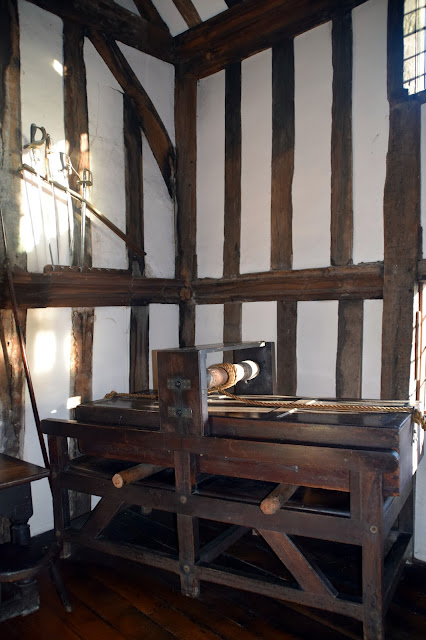The Hospital is an historic group of timber-framed buildings on Warwick
High Street dating mainly from the late 14th Century clustered round the
Norman gateway into the town with its 12th Century Chantry Chapel above
it. For nearly 200 years it was home to Warwick’s medieval Guilds.
In the reign of Queen Elizabeth I it became, under the patronage of
Robert Dudley, Earl of Leicester, a place of retirement for old warriors
known as the Brethren. The Brethren and Master, who still live within
the walls of the building, are a living legacy of almost 450 years of
history. Every morning they meet in the Chapel and pray together the
words their founder Robert Dudley set down.
The Charter set up a corporation of a Master (a clergyman) in charge
and twelve resident Brothers. The Master moved into the house which
Thomas Oken had previously occupied in the days of the Guilds and parts
of the buildings, including the Guildhall itself, were divided into
primitive quarters for the Brethren. The establishment was endowed with
estates producing an income of some £200 per year.
This 19th Century engraving (above) depicts the Courtyard of the
Hospital with two of the Brethren in conversation, a third lurking in
the corner and a fourth Brother on the stairway up to the Guildhall.
An arcade supports the gallery running along the eastern side of the
courtyard. Beneath this is the Brethren’s Kitchen where the Brothers
prepared their food. The Archway leads through to the front of the
hospital buildings facing the High Street of Warwick
The Brethren were clothed in a traditional uniform of Tudor hat and
black gown. This is adorned with a silver badge of the “Bear and Ragged
Staff” device of the Dudley family surmounted by an earl’s coronet,
reputedly given by Queen Elizabeth I to each of the twelve founding
Brethren.

The historic group of buildings which now
comprise the Hospital is dominated by the ancient Chapel of St James
the Great, built over the West gate into the town of Warwick.
The original chapel was built by Roger
de Newburgh, the second Norman earl of Warwick in 1126. It was used by
travellers departing from, and returning to, the town. Roger’s wife
died quite young and so it became a Chantry Chapel in which the priests
celebrated the Mass for the repose of her soul.
Under a licence issued by King Richard
II on 20th April 1383 was created the Guild of St George. In 1386
Thomas Beauchamp, 12th Earl of Warwick, granted the benefice of the
Chapel to the Guild and rebuilt it. The tower was added and the gate
underneath was extended.
Some time between then and 1413, the
Guilds of the Holy Trinity and of the Blessed Virgin Mary, previously
based at the Collegiate Church of St Mary, moved to the site and
accommodation for the Guilds and the resident priests was erected
together with reception, meeting and dining halls. They became known as
the United Guilds of Warwick.
In 1860 an extensive restoration was
undertaken by Sir Gilbert Scott whose representative was summoned from
his dinner in the nearby village of Barford by anxious townsfolk who
feared that the chapel was about to collapse into the road beside it.
















































No comments:
Post a Comment